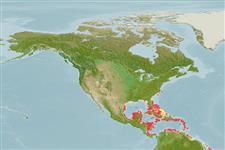Common names from other countries
Classification / Names / Names
Nomi Comuni | Sinonimi | Catalog of Fishes (gen., sp.) | ITIS | CoL | WoRMS
Environment: milieu / climate zone / depth range / distribution range
Ecologia
Associati a barriera corallina; salmastro; distribuzione batimetrica 0 - 18 m (Ref. 108813). Tropical
Western Central Atlantic.
Length at first maturity / Size / Peso / Age
Maturity: Lm ? range ? - ? cm
Grows in either in vase-, tube- or cup-shape, broadening upward from the base up to 50 cm in height. Fan-shape rare; may be globular or tubular in small specimens. Surface smooth or with conules or soft spines up to 6 mm in height ; coarsely porous. Color varies from pale purplish pink to light bluish to grayish green or gray. Compressible. Small round oscules present inside the vase or cup. A fringe of soft spines usually connected by a transparent membrane is present at the apical opening (Ref. 85482).
On coral reefs and hard bottoms (Ref. 85482), and in mangroves (Ref. 86836). Commensal with amphipods (Ref. 86735). In Belize, it was found in a submarine cave near Columbus Cay at a depth of 10 m (Ref. 87209).
Life cycle and mating behavior
Maturità | Riproduzione | Deposizione | Uova | Fecundity | Larve
Members of the class Demospongiae are hermaphroditic. Life cycle: The zygote develops into parenchymella larva (free-swimming) before settling down on a substrate where it grows into a young sponge.
Engel, S. and J.R. Pawlik. 2005. (Ref. 837)
IUCN Red List Status (Ref. 130435)
CITES status (Ref. 108899)
Not Evaluated
Not Evaluated
Human uses
| FishSource |
Strumenti
Informazioni ulteriori
Age/SizeAccrescimentoLength-weightLength-lengthMorfologiaLarveAbbondanza
Fonti Internet
Estimates based on models
Preferred temperature
(Ref.
115969): 25.5 - 28.2, mean 27.3 (based on 446 cells).
Price category
Unknown.
